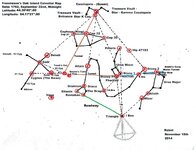gjb
Full Member
- Apr 21, 2016
- 240
- 307
- Detector(s) used
-
Garrett Ace 300i
Garrett EuroAce
- Primary Interest:
- All Treasure Hunting
The Lat.Long... I derived from the Google Map supplied by Forum Member Charlie P. (NY) post # 5 on this thread.
https://www.google.com/maps/place/4...3159846,7392m/data=!3m1!1e3!4m2!3m1!1s0x0:0x0
.
Robot
I clicked the link you gave above, and this shows what I provided as the Lat.Long: N 44 31', 64 18' W. So, from GPS readings obtained personally, I’d say the triangle lies at about N 44 30' 45", 64 17' 20" W (rounded to nearest 5"). It cannot possibly be where you’re saying.
As to the date, I’ve used Stellarium to give me a starting point, and the stars still seem wrong. I make it about 02.30 a.m. before i Bootis is in the right position. Don’t do anything fancy, just set the location, then the date and time, and pan to north. It might even be better if somebody else on the forum tries it!






